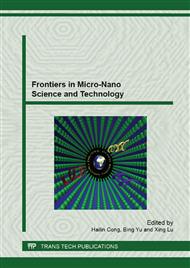[1]
A. Fujishima, K. Honda, Electrochemical photolysis of water at a semiconductor electrode , Nature 238 (1972) 37-38.
DOI: 10.1038/238037a0
Google Scholar
[2]
H. Zhang, X.J. Zhang, Application of nanometer TiO2 photocatalytic technology in the treatment of industrial wastewater, Journal of Environment and Health 27 (2010) 1027-1029.
Google Scholar
[3]
A. Fan, Y. Zu, X.J. Li, Research progress of nanometer TiO2 purifying atmosphere in Japan, Titanium Industry Progress 3 (2000) 40-41.
Google Scholar
[4]
T. Hitosugi, N. Yamada, S. Nakao, Y. Hirose, T. Hasegawa, Properties of TiO2-based transparent conducting oxides, Phys. Status Solidi A 207 (2010) 1529–1537.
DOI: 10.1002/pssa.200983774
Google Scholar
[5]
Y.J. Li, J. Li, M.Y. Ma, Y. OU, Z. Yu, W.B. Yan, Preparation of TiO2/activated carbon with Fe ions doping photocatalyst and its application to photocatalytic degradation of reactive brilliant red K2G, Science in China Series B: Chemistry 52 (2009).
DOI: 10.1007/s11426-009-0169-x
Google Scholar
[6]
B. O'regan, M. Gr tzel, A low-cost, high-efficiency solar cell based on dye-sensitized colloidal TiO2 films, Nature 353 (1991) 737-740.
DOI: 10.1038/353737a0
Google Scholar
[7]
S. Sakthivel, M. Janczarek, H. Kisch, Visible light activity and photoelectrochemical properties of nitrogen-doped TiO2, J. Phys. Chem. B 108 (2004) 19384-19387.
DOI: 10.1021/jp046857q
Google Scholar
[8]
J.L. Gole, J.D. Stout, C. Burda, et al., Highly efficient formation of visible light tunable TiO2-xNx photocatalysts and their transformation at the nanoscale, J. Phys. Chem. B 108 (2004) 1230-1240.
DOI: 10.1002/chin.200417021
Google Scholar
[9]
M. Mrowetz, W. Balcerski, A. J. Colussi, M. R. Hoffmann, Oxidative power of nitrogen-doped TiO2 photocatalysts under visible illumination, J. Phys. Chem. B 108 (2004) 17269-17273.
DOI: 10.1021/jp0467090
Google Scholar
[10]
Y. Izumi, T. Itoi, S. Peng, Site Structure and Photocatalytic Role of Surfur or Nitrogen-Doped Titanium Oxide with Uniform Mesopores under Visible Light, J. Phys. Chem. C 113 (2009) 6706–6718.
DOI: 10.1021/jp810817y
Google Scholar
[11]
R.H. Zhang, Q. Wang, Q. Li, J.F. Dai, D.H. Huang, First-principle calculations on optical properties of C–N-doped and C–N-codoped anatase TiO2, Physica B 406 (2011) 3417-3422.
DOI: 10.1016/j.physb.2011.06.011
Google Scholar
[12]
H.W. Peng, J.B. Li, S.S. Li, B.X. Jian, First-principles study of the electronic structures and magnetic properties of 3d transition metal-dopedanatase TiO2, Journal of Physics: Condensed Matter 20 (2008) 125207-125212.
DOI: 10.1088/0953-8984/20/12/125207
Google Scholar
[13]
J.F. Zhu, Z.G. Deng, F. Chen, J.L. Zhang, H.J. Chen, J. Huang, L. Zhang, Hydrothermal doping method for preparation of Cr3+-TiO2 photocatalysts with concentration gradient distribution of Cr3+, Appl. Catal. B: Environ 62 (2006) 329–335.
DOI: 10.1016/j.apcatb.2005.08.013
Google Scholar
[14]
X.H. Wang, J.G. Li, H. Kamiyama, Y. Moriyoshi, T. Ishigaki, Wavelength-sensitive photocatalytic degradation of methyl orange in aqueous suspension over iron(III)-doped TiO2 nanopowders under UV and visible light irradiation, J. Phys. Chem. B 110 (2006).
DOI: 10.1021/jp060082z
Google Scholar
[15]
L.S. Yin et al, Photocatalytic degradation of chloramine phosphorus with RE doped TiO2, Journal of Central South University 40 (2009) 139-144.
Google Scholar
[16]
G.X. Li, J.Q. Zhang, D.R. Feng, J.P. Guo, Study on the Photocatalysis Degradation of 2, 4-DNP by a Praseodymium-Doped Nanometer TiO2, Chinese Rare Earth 28(2007) 37-39.
Google Scholar
[17]
M.D. Segall, P.J.D. Lindan, M.J. Probert, C.J. Pickard, P.J. Hasnip, S.J. Clark, M.C. Payne, First-principles simulation: ideas, illustrations and the CASTEP code, J. Phys.: Condens. Matter 14 (2002) 2717–2744.
DOI: 10.1088/0953-8984/14/11/301
Google Scholar
[18]
M.C. Payne, M.P. Teter, D.C. Allan, T.A. Arias, J.D. Joannopoulos, Iterative minimisation techniques for ab initio total-energy calculations: molecular dynamics and conjugate gradients, Rev. Mod. Phys 64 (1992) 1045-1097.
DOI: 10.1103/revmodphys.64.1045
Google Scholar
[19]
J.P. Perdew, K. Burke, M. Ernzerhof, Generalized gradient approximation made simple, Phys. Rev. Lett 77 (1996) 3865–3868.
DOI: 10.1103/physrevlett.77.3865
Google Scholar
[20]
J.K. Burdett, T. Hughbanks, G.J. Miller, J.W. Richardson, Jr., J.V. Smith, Structural-Electronic Relationships in Inorganic Solids: Powder Neutron Diffraction Studies of the Rutile and Anatase Polymorphs of Titanium Dioxide at 15 and 295 K, J. Am. Chem. Soc. 109 (1987).
DOI: 10.1021/ja00246a021
Google Scholar
[21]
R.S. Mulliken, Electronic Population Analysis on LCAO–MO Molecular Wave Functions, I, J. Chem. Phys. 23 (1955) 1833–1840.
DOI: 10.1063/1.1740588
Google Scholar
[22]
J. Sato, H. Kobayashi, Y. Inoue, Photocatalytic Activity for Water Decomposition of Indates with Octahedrally Coordinated d10 Configuration. II. Roles of Geometric and Electronic Structure, J. Phys. Chem. B 107 (2003) 7970-7975.
DOI: 10.1021/jp030021q
Google Scholar
[23]
M.C. Long, X.Y. Chai, B.X. Zhou, W.M. Cai, G.Z. Liu, Correlation of electronic structures and crystal structures with photocatalytic properties of undoped, N-doped and I-doped TiO2, Chem. Phys. Lett. 420 (2006) 71-76.
DOI: 10.1016/j.cplett.2005.12.036
Google Scholar
[24]
H. Tang, H. Berger, P.E. Schmid, F. Levy, Optical properties of anatase (TiO2), Solid State Commun. 92 (1994) 267–271.
DOI: 10.1016/0038-1098(94)90889-3
Google Scholar
[25]
X.D. Liu, E.Y. Jiang, Z.Q. Li, Q.G. Song, Electronic structure and optical properties of Nb-doped anatase TiO2, Appl. Phys. Lett. 92 (2008) 252104.
DOI: 10.1063/1.2949070
Google Scholar
[26]
K. Osuch, E.B. Lombardi, W. Gebicki, A first principles study of ferromagnetism in ZnO: Ti, Phys. Rev. B 73 (2006) 075202.
Google Scholar
[27]
J.P. Perdew, M. Levy, Physical content of the exact Kohn-Sham orbital energies: band gaps and derivative discontinuities, Phys. Rev. Lett. 51 (1983) 1884–1887.
DOI: 10.1103/physrevlett.51.1884
Google Scholar
[28]
R. Asahi, T. Morikawa, T. Ohwaki, et al., Visible-light photocatalysis in nitrogen-doped titanium oxides, Science 293 (2001) 269-271.
DOI: 10.1126/science.1061051
Google Scholar


